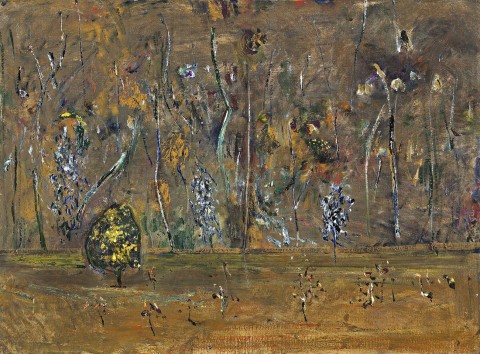ACACIAS IN THE YOU YANGS II, 1978
FRED WILLIAMS
oil on canvas
71.0 x 96.5 cm
bears inscription verso: FRED WILLIAMS / LW 692 / ACACIAS IN THE YOU YANGS II / 1978 / Lyn Williams 1999
Estate of the artist, Melbourne (stamped and label attached verso)
Philip Bacon Galleries, Brisbane (label attached verso)
Private collection, Hobart, acquired from the above in April 2000
Fred Williams, Philip Bacon Galleries, Brisbane, 4 April – 6 May 2000, cat. 35 (illus. in exhibition catalogue)
In Fred Williams’ Acacias in the You Yangs II, 1978, golden wattle lights the forest darkness, luminous of palette and texturally rich. Its radiance draws the eye, expectant with the mystery of germination and the promise of spring. Once again Williams displays his wonders of invention in response to the creative powers of nature, singular, visually and intellectually seductive. As master of his art, illusion of depth is balanced by emphasis on the picture plane, leading to an absorbing dialogue between realism and abstraction. Scumbled and calligraphic daubs of paint contrast with painterly luxuriance in the marriage of contraries. Close-up in view, the ascending background and absence of horizon increase the intimacy of the pictured moment. The subtle beauty of the floating forms tells of the felicitous influences of Chinese art, much enjoyed during Williams’ visit to China in 1976.
Williams’ interest in painting wattle goes back to the winter of 1969 when he visited Clifton Pugh at ‘Dunmoochin’ in Cottlesbridge, north-east of Melbourne. Writing in his diary for 24 July, he said he found it ‘fascinating painting the wattles’. The following day he added: ‘I would really like to work from them as they mature’.1
The distinctive granite ranges of the You Yangs near Geelong and their flat volcanic plains inspired many of Williams’ finest earlier works, especially those from his more minimalist period. Key paintings, You Yangs II (National Gallery of Australia, Canberra) and You Yangs Pond (Art Gallery of South Australia, Adelaide), both of 1963, typify the aerial view and scrubby landscape. In 2017, the significance of the You Yangs in his oeuvre was acknowledged by the Geelong Gallery when it gave their major exhibition the title – ‘Fred Williams in the You Yangs: a turning point for Australian art’. When Williams returned to the You Yangs in 1978, the year of our painting, his art had become richer through the introduction of a broader range of colours, more expressive in style and less abstract. In some, Hillside Landscape with Green Tractor, You Yangs, 1978, (Deutscher and Hackett, 20 April 2011, lot 21) for example, he adopted a more traditional view. Wattle, however, still had Williams in its thrall to the extent that he painted a series of four works titled ‘Acacias in the You Yangs’ this same year. Touching on the sequential and tending towards realism, each presents that unique vision of our landscape for which Williams is so admired.
They were exhibited together in a mini-survey in Brisbane in 2000. In each, the landscape is viewed closer, more intimately, mastery of handling giving them the immediacy of having been painted en plein air.2 Moreover, the sense of location has deepened – in presence, mood and motif. Lyn Williams, in the introduction to the exhibition’s catalogue, wrote that these works from the 1970s were usually ‘painted directly outdoors on painting trips, although some are painted from memory in the studio’.3 She continued: ‘They are more evocative of the mood of the day – summer, winter, evening or morning light and very painterly in feeling’.
1. Quoted in Mollison, J., A Singular Vision: The Art of Fred Williams, Australian National Gallery, Canberra, 1989, p. 174
2. Fred Williams – Paintings, 1959-1978, Philip Bacon Galleries, Brisbane, 4 April – 6 May 2000, cats. 34 – 37
3. Williams, L., catalogue introduction, ibid.
DAVID THOMAS
